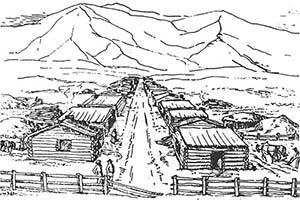The Mendon Fort ~ Index

Mendon was not a fort in the stricter sense of the word, but it answered the purpose of a fort. It was built with a view of protection from the Indians that roamed the country at that time. The fort was commenced in 1856 or 1857, when Alexander and Robert B. Hill, sons of Daniel Hill, a miller from Brigham came and located farms near the northeast corner of where Mendon now stands.
In the spring and summer of 1859 came the greatest influx of pioneers to Mendon. About March 1st, Rodger Luckham with his two daughters, Mary and Susan, and Robert Sweeten his stepson, Alfred and Charley Atkinson, two little Englishmen and their families, all from Mill Creek arrived here. Following them in quick succession were James G. Willie from Salt Lake, John and Hyrum T. Richards, James H. Hill and Peter Larsen all from Mill Creek. The Sorensen brothers (Peter and Isaac) residing at Maughan’s Fort also came at this time. Then others arrived, among them Charles, William, Kelsey and Bradford Bird, Ralph Foster, Hans Jensen, William Findley, Charles and Andrew P. Shumway, Andrew Andersen, Jasper Lemmon, Manning Rowe, Henry Hughes, John Donaldson, James McBride, Winslow Farr, Gibson and Dabell, the Baker bothers (Amenzo, Albert, George and Joseph), Lorme ? Hancock, Gardner, Wood, Shelton, (Henry) Stokes, Smyths and perhaps others.
In August 1859 Jessie W. Fox, Sr. a surveyor from Salt Lake City surveyed and played out the Old Fort, also the fields adjourning the fort. At this time the pioneers were all living in their tents and wagons. They now built their log houses and dugouts, the fort being about two and one half blocks long. The houses were built of logs the men going to the canyon or river bottom for them. They were either pine or cottonwood. The men usually went to the canyons or fields in companies so as to give better protection against the Indians.
This fort consisted of two rows of houses facing each other, running east and west, with a space or roadway between the two rows. About in the center of the fort a road ran north and south, this being the only opening to get through the fort. The house consisted of one room with ground for the floor. The logs were hewn smooth on one side for the inside of the house, and placed on on top of the other to the square and clay was used to fill up the chinks.
The roof consisted of a number of straight saplings being placed close together, then covered with a covering of long wheat grass or straw, when it could be obtained. Then a thick covering of dirt. In the back of each row of houses was a garden spot and back of this were the corrals and stockyards. Some of the people raised their gardens on their farming land.
The farming land reached to the south as far as the Mill Pond or what we now call Clayton. It reached north as far as Richards Spring, and east as far as the (Little Bear) River.
Charles Shumway was authorized to take charge of the public affairs of the new settlement until his son, Andrew P. Shumway was ordained bishop, on December 18th, 1859.
The first meetings were held in private cabins during the winter. Rodger Luckham let the singing and Ira Ames played the fiddle.
In the winter of 1859-1860 the men of the fort went to the canyons of Cache Valley both east and west to get fine logs with which to build a public house. The structure was 18 feet by 24 feet and served for worship, school and recreation.
In the spring of 1861 the United States Post Office was established here. In the spring of 1861 the men turned out in mass and build a dam across Gardner’s Creek in which to irrigate their farms. The first Sunday school was held in 1863 with James G. Willie as superintendent.
They lived in the fort five years then in the spring of 1864 a town plot was surveyed and the families moved from the old fort to their city lots.
The city was incorporated, March 12th, 1870-1910.
Notes…
Robert Brice Hill had built a small cabin along the bank of the stream, about two-hundred feet east, from where 276 North 100 East would be today. They had the first house in what would later become Mendon, Utah prior to the general move to Cache Valley in 1859.